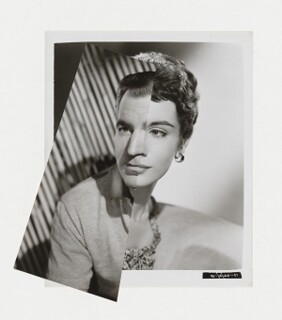At the Photographers' Gallery
Brian Dillon
At John Stezaker’s studio in Kentish Town an entire wall is given over to a photographic archive the artist bought about thirty years ago. Britain’s cinemas had been going out of business for decades, and with them the picture agencies that supplied the industry with film stills and actor portraits. Stezaker snapped up the contents of one such doomed establishment, but has done nothing with them since. (Though he has plans, he says.) Look around the studio, and you get a queasy sense of the fate that might await those black-and-white prints. There are forgotten starlets half decapitated, neatly enucleated character actors, scenes from long-lost B-movies invaded by lurid portions of landscape or Kodachrome bouquets. And here and there a scalpel, threatening the surface of an intact print.
Stezaker is not strictly speaking a photographer (his winning the Deutsche Börse Photography Prize has provoked a mild and predictable controversy). For nearly 40 years – he is now 63 – he’s been engaged on a remarkably consistent body of work that has its roots in the conceptual art of the 1970s and the longer history of photomontage, which is almost as old as the medium it cannibalises. The best known monteurs – John Heartfield, Hannah Höch, Linder Sterling – tend to be hyperactive at the levels of visual texture and more or less startling juxtaposition. But Stezaker’s is a laconic practice, often requiring no more (though it’s really quite a lot) than the scrupulous positioning of one picture on top of another.
In several works a colour postcard has been placed over a studio portrait or film still, matching certain portions of the main image (the curve of a brow, the jut of a jaw) to tree-lines and the profiles of rock outcrops. In Siren Song V (2011), the monochrome actress’s face is obscured by a hand-tinted wave on a colour postcard, which crashes just where we guess her hair might be. The effect is witty but monstrous, as it is in the similar Masks series: studio portraits of the 1930s and 1940s are overlain by Romantic postcard views, so that mellow flesh once subject to the retoucher’s art is gouged by cavernous voids or shredded into foliage.
Stezaker’s art is discrete and modestly scaled – he usually shows montaged originals, occasionally rephotographed enlargements – but surprisingly violent. (It is hard not to think of photographs of real facial disfigurement taken by the surgeon Harold Gillies during and after the First World War.) Several series involve pairs of vertically bisected portraits. Moody or grinning half-actors are spliced together to produce physiognomies that are oddly plausible, and all the more unsettling as a result. Hairlines, lips and bodily attitudes may align perfectly, as in Muse (Film Portrait Collage) XVIII (2012) or Marriage (Film Portrait Collage) LXIV (2010), but the gazes frequently diverge, so that many of these new faces have a dreamy strabismus. Stezaker has a thing about eyes (perhaps another residue of Surrealism), perverting his found subjects’ gazes or excising them entirely, while holding his viewers’ rapt.
